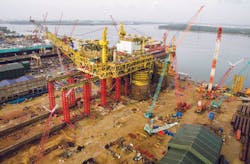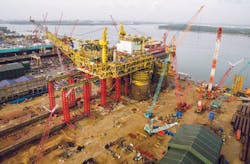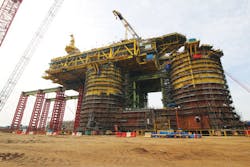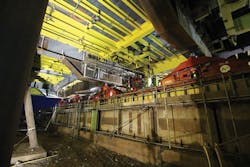Facility is first platform of its type in Malaysian sector
Taco Vissers, Sarah Maia
ALE
Last month, the IEV Malaysia/Hereema Marine Contractors and SapuraKencana joint venture was due to towSabah Shell’s new Malikai tension-leg platform (TLP) from Singapore to its offshore location, 100 km (62 mi) offshore Sabah, Malaysia in 500 m (1,640 ft) water depth.
Malikai is Shell’s second deepwater project off Malaysia after Gumusut-Kakap, which started production in 2014. The oil field, in the block G PSC, comprises two main reservoirs: the 27,500-metric ton (30,313-ton) TLP - Malaysia’s first - will have capacity to produce up to 60,000 b/d of oil, which will be exported 50 km (31 mi) to the shallow-water Kebabangan platform for processing. Associated produced gas will be used to generate power on the platform and as lift gas for the oil.
This June, Shell and the Technip-Malaysia Marine Heavy Engineering (MMHE) joint venture (TMJV) completed onshore fabrication and commissioning of the TLP at Pasir Gudang in Peninsular Malaysia. Prior to the departure of the TLP from the MMHE yard,ALE had been responsible for the platform assembly operation, its scope covering weighing and transporting of four unit hull blocks, living quarters and mega beams for the “Superlift” activities; weighing, skidding and jacking-up of the topside; skidding the topsides at height over the hull, followed by mating of the two structures; and load-out of the completed TLP.
The most notable operation was the jacking-up of the 13,800-metric ton (15,212-ton) topsides to a height of 40 m (131 ft) - the highest ever for an offshore structure of this scale. When jacked-up, the topsides and its equipment weighed a combined 17,300 metric tons (19,070 tons).
The topsides was then skidded a distance of 90 m (295 ft) at elevation until it was above the hull for the mating operation. During skidding, which was completed in 12 hours, the accelerations of the topsides at the height of 40 m caused higher displacements than anticipated. To resolve this situation, both masts in the hull area (which had a very stiff and heavy base) were coupled using ALE’s Mega Jack heavy lift jacking system, which had a relatively light base and was therefore not very stiff. After jacking-up the topsides, the jacking beam and mega beams (both above the hull) were coupled using a link beam and fixed connections. These link beams transferred the horizontal load of the skidding acceleration to both systems.
Subsequently, the TLP, weighing 27,500 t at this stage, was loaded out onto theWhite Marlin transportation vessel via a 60-m (197-ft) skidding operation involving the use of eight strand jacks fitted with 39 strand wires, giving a total pull capacity of 5,928 metric tons (6,534 tons). In addition to the pulling operation for the load-out, ALE’s barge level monitoring system allowed the company and the client to constantly monitor the vessel trim, heal and deck shape in real time throughout the load-out process. The monitoring system also provided details of the distance pulled onto the vessel and the total distance left to completion.
There were many challenges throughout the campaign. The Superlift design required the construction of large beams, 4 m (13 ft) high and up to 80 m (262 ft) long, to meet Technip’s engineering demands and the MMHE yard’s operational requirements. ALE designed the system to handle a relatively large tolerance. Also, the topsides, hull, the heavy lift jacking system, skidding system, support beams, support masts and load-out supports all needed to be built with certain tolerances relative to each other. Without appropriate accuracy and dimension checks, the topside would not mate to the hull after jacking and skidding. The various dimension control documents were therefore assembled to check if the topsides and hull would fit, prior to the start of the first skidding operation.
ALE designed the dimension control procedure with TMJV, maintaining regular dialogue with Technip’s engineering office in Kuala Lumpur and the MMHE yard in Pasir Gudang. Previous experiences with large settlements and high wind speeds led the company to investigate the effect of different external factors. However, it became clear that the accelerations of the topside when skidding on height would have much more of an impact than both wind and settlement. Because the topsides is relatively heavy compared to the jacking system underneath, the second-order effects caused large displacements at the top; when the jacking system was 1 mm different at the bottom, this meant a displacement of more than 15 mm (0.6 in.) at the top. Furthermore, the accelerations of the skidding system could cause displacements of up to 300 mm (11.81 in.).
To resolve this issue, ALE investigated the option of adding bracings, developing numerous finite element (FE) models to assess their optimum position and angle. The bracings also needed to be lengthened during jacking up, making the application of fixed solutions such as pipes or masts extremely time consuming. Strand jack bracings were therefore introduced which would be extended and synchronized with the heavy lift jacking system. FE models took into account each different pretension, the number and type of strands, and strand jack positions. The solution adopted ensured the complete system displacements during jacking would be within the allowable limits.
Because this project was one of the first “skidding-at-height-projects” involving such heavy modules, many different parties were involved in checking and confirming the strength of the heavy-lift jacking system. ALE had direct contact with different sections of TMJV and the main contractor, SSPC.
The team performed thorough risk assessments and implemented special safety measures introduced. As both the heavy lift and skidding systems are operated remotely via a control room and are equipped with computerized controls, which in turn have numerous inbuilt safety systems, these provided a safe way of working and protected both workers and the client’s equipment during lifting. To minimize the horizontal displacements at the top of the jack-up, stability bracings (strand jacks) were applied to stabilize the heavy lift system. These strand jacks were to be kept under pre-tension during jack-up and effective communication was key to the success of this operation.
The Mega Jack, with its capacity to easily lift the topsides to the desired height, permitted the client to work on both the topsides and the hull on ground level, therefore optimizing the logistics needed for such a build as well as providing a safer solution with a reduction in working at height.
All separate items had to be aligned and positioned precisely, to meet the correct end position of the topside within a few millimeters. This was a major challenge, which ALE managed with TMJV. The client imposed a tight deadline to ensure all offshore components were assembled by a pre-determined date. Because the equipment was easy to mobilize and handle, and despite the challenges faced on-site, the Superlift was completed without any delay to the project’s schedule.







